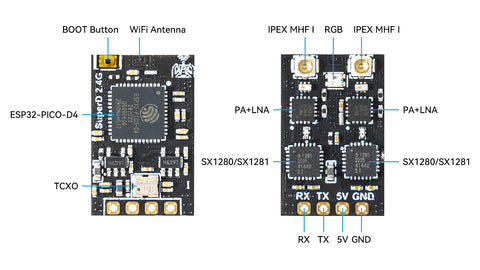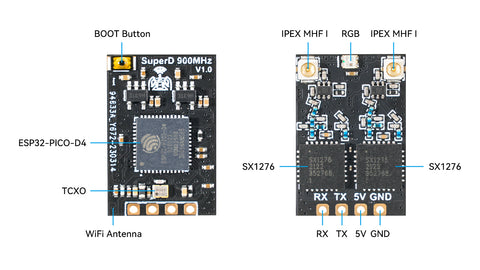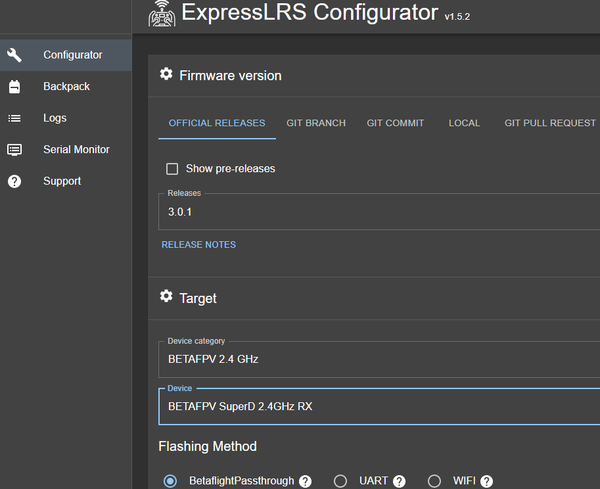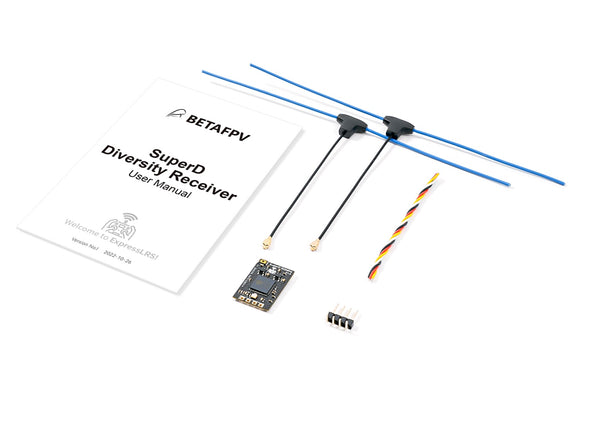A ton of ExpressLRS items are available now!

- A true diversity receiver with two complete RF receiver chains (referring to dual SX1280/SX1281 or dual SX1276), based on the latest official ExprssLRS. It comes with ExpressLRS V3.0.0 firmware.
- Ultralight weight is only 1.1g without the antenna. The receiver board features a reasonable layout and is impeccably clean. Very easy to solder.
- Two Dipole T antennas will create an omnidirectional signal for good signal transmission. Placing the antenna separately and vertically as far apart as possible to get a better signal is recommended.
- Not only it is used for FPV drones but also for FPV fixed-wing, or other FPV aircraft. It has superb performance in long-range flying.
- The first true diversity receiver for the 915MHz/868MHz frequency bands, with two separate receiving modules working together to improve signal reception quality and overall reliability.
- The 900MHz radio system exhibits greater diffraction ability due to its lower frequency, while the 2.4GHz systems tend to be directional and susceptible to attenuation caused by buildings, foliage, or moisture.
- Item: BETAFPV SuperD ELRS 2.4GHz/915MHz/868MHz Diversity Receiver
- MCU: ESP32 PICO D4, dual SX1280(SX1281) (2.4GHz) / dual SX1276 (915MHz/868MHz)
- Telemetry power: 20dBm (2.4GHz) / 17dBm (915MHz/868MHz)
- Weight excluding antenna: 1.1g (2.4GHz) / 1.2g (915MHz/868MHz)
- RF Frequency: 2.4GHz (ISM) / 915MHz FCC/868MHz EU
- Antenna connector: IPEX MHF 1/U.FL
- Input voltage: +5V DC @ “+” pad
- Receiver protocol: CRSF
- PCB size: 22mm x 14mm
SuperD ELRS 2.4GHz Diversity Receiver is built-in a TCXO (temperature compensated crystal oscillator), which is shared by two RF chips for a super accurate clock source. The true diversity receiver including two RF chips and PA+LNA will generate a large amount of heat when working. With the high-quality TCXO, it can withstand extreme temperatures with no fear of heat and cold, continuously outputting accurate frequency for long-range flight. Click to learn more about the TCXO.
BETAFPV ExpressLRS Receivers
| SuperD RX | Micro RX | Nano RX | Lite RX | |
| Weight | 1.1g (2.4GHz), 1.2g (915/868MHz) | 3.5g (RX only) | 0.7g (RX only) | 0.47g (Tower), 0.53g (Flat) |
| Antenna | IPEX MHF1 + T antenna | IPEX MHF1 + T antenna | IPEX MHF1 + T antenna | SMD ceramic antenna |
| MCU | ESP32-PICO-D4 | ESP8285 | ESP8285 | ESP8285 |
| RF Chip | Dual SX128X + Dual PA (2.4GHz), Dual SX1276 (915/868MHz) | SX128X | SX128X + PA, SX1276 + PA | SX128X |
| Frequency | 2.4GHz ISM, 915MHz (FCC), 868MHz (EU) | 2.4GHz ISM | 2.4GHz ISM, 915MHz (FCC), 868MHz (EU) | 2.4GHz ISM |
| Telemetry Power | 100mW | 17mW | 100mW | 17mW |
| Serial Output Protocol | CRSF | PWM or CRSF | CRSF | CRSF |
| Model Type | FPV Drone, Fixed-wing aircraft | Fixed-wing aircraft, Helicopter, RC Cars, RC Boats | FPV Drone | Whoop Drone |
Diagram


| RGB Color | Status | Description |
| Rainbow | Fade effect | Power on |
| Green | Slow flash | WIFI upgrading mode |
| Red | Quick flash | No RF chip detected |
| Orange | Double flash | Binding mode |
| Orange | Triple flash | Connected, but mismatched model-match configuration |
| Orange | Slow flash | Waiting for connection |
| Solid on | Connected and color indicates packet rate |
2.4GHz:
Note: F1000 and F500 are packet rates in FLRC mode, providing faster modulation and lower latency, but at the same time having shorter reception distance than normal Lora mode. This mode is great for racers.
915MHz/868MHz:
Note: D50 is a unique mode of ELRS Team900. Under the 200Hz refresh rate of Lora mode, the same data packet is repeatedly sent four times, and the receiving distance is equivalent to 200Hz.
Configuration & Bind
The connection between the SuperD diversity receiver and the flight controller is shown in the figure below
Connect the flight controller to the Betaflight Configurator for basic configuration. First, on the "Port" page, enable the flight controller serial port (take UART1 as an example) as "Serial Rx".
On the configuration page, set Receiver Mode to Serial (via UART) and Serial Receiver Provider to CRSF.
The default firmware of the SuperD diversity receiver uses the ExpressLRS V3.0.0 protocol and has no preset binding phrase. Therefore, the firmware version of the transmitter module must be ExpressLRS V3.0.0 or later versions. Both the receiver and transmitter module should not have any binding phrase.
- Note: After binding once, the receiver will remember the autosaved binding phrase and device. Further restarting of the device will be bound automatically without the need for a rebinding process.
- 1* SuperD 2.4GHz Diversity Receiver
- 2* 2.4GHz T Antenna
- 1* 4-Pin Header
- 1* 4-Pin Wire Harness
- 1* Instruction Manual
- 2* Heat Shrink Tubing
- 1* SuperD 915MHz/868MHz Diversity Receiver
- 2* 915MHz/868MHz T Antenna
- 1* 4-Pin Header
- 1* 4-Pin Wire Harness
- 1* Instruction Manual
- 2* Heat Shrink Tubing

Note: Firmware for 915MHz/868MHz is currently self-compiled firmware.
FAQ
- Know More About ExpressLRS


Welcome to My Store